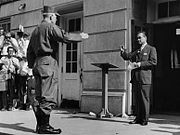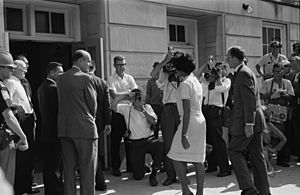Stand in the Schoolhouse Door facts for kids
Quick facts for kids Stand in the Schoolhouse Door |
|||
|---|---|---|---|
| Part of the Civil Rights Movement | |||

Attempting to block integration at the University of Alabama, Governor of Alabama George Wallace stands at the door of Foster Auditorium while being confronted by U.S. Deputy Attorney General Nicholas Katzenbach.
|
|||
| Date | June 11, 1963 | ||
| Location | |||
| Caused by |
|
||
| Resulted in |
|
||
| Lead figures | |||
|
|||
The Stand in the Schoolhouse Door was an important event in the Civil Rights Movement. It happened at Foster Auditorium at the University of Alabama on June 11, 1963.
George Wallace, who was the Governor of Alabama, tried to stop two African American students from entering the university. He stood in the doorway of the auditorium. This was a symbolic act to keep his promise of "segregation now, segregation tomorrow, segregation forever." Segregation means keeping people of different races separate.
President John F. Kennedy responded by ordering the Alabama National Guard to follow federal (national) orders. General Henry V. Graham of the Guard then told Governor Wallace to move. Wallace spoke for a bit, but he eventually stepped aside. The two students, Vivian Malone and James Hood, were then able to register for their classes. This event made Governor Wallace well-known across the country.
Why the Stand Happened
The story of the Stand in the Schoolhouse Door starts with a big court case. On May 17, 1954, the Supreme Court of the United States made a decision in a case called Brown v. Board of Education. The court said that having separate public schools for black and white children was against the law. This meant that schools, including the University of Alabama, had to allow students of all races.
After this decision, many African Americans tried to get into the University of Alabama. But for many years, almost all of them were turned away. The university and police tried to find reasons to deny them. Sometimes, they even tried to scare applicants away.
However, in 1963, three African American students—Vivian Malone Jones, Dave McGlathery, and James Hood—applied. A federal judge ordered that they must be allowed to enroll. The judge also told Governor Wallace not to get in the way.
Governor Wallace did not want violence to break out, like what had happened at the University of Mississippi in 1962. He secretly told his police chief to warn groups like the Ku Klux Klan to stay away from Tuscaloosa. He wanted to make sure there were no big crowds or fights. But Wallace still refused to talk directly with Attorney General Robert F. Kennedy about his plans.
What Happened on June 11, 1963


On the morning of June 11, Vivian Malone and James Hood completed most of their registration paperwork in Birmingham. They then went to Foster Auditorium in Tuscaloosa to finish up and pay their fees.
Officials from President Kennedy's government were worried about violence. They thought about taking Malone and Hood straight to their dorms. But they decided it was better to let Governor Wallace make his stand. This way, it would look like a disagreement between the state and federal governments, not a fight between the governor and the students.
So, Malone and Hood stayed in their car. Governor Wallace stood in the doorway of Foster Auditorium, with many news reporters watching. He was trying to keep his promise to support segregation.
Then, Nicholas Katzenbach, a top lawyer for the U.S. government, walked up to Wallace. He was joined by federal marshals. Katzenbach told Wallace to move. But Wallace interrupted him and gave a speech about "states' rights." This idea meant that states should have more power than the federal government.
Katzenbach called President Kennedy. Kennedy had already issued a special order telling Wallace to step aside. Since Wallace ignored it, Kennedy then issued another order, s:Executive Order 11111. This order allowed the President to take control of the Alabama National Guard.
About four hours later, General Henry V. Graham of the National Guard told Wallace to move. He said, "Sir, it is my sad duty to ask you to step aside under the orders of the President of the United States." Wallace spoke a bit more, but then he finally moved. Vivian Malone and James Hood were then able to go inside and finish registering for their classes.
What Happened Next
After the event, the National Guard stayed on campus for a few days. This was because there were still groups like the Ku Klux Klan in the area. Governor Wallace and President Kennedy exchanged angry messages about the Guard staying there. Wallace thought Kennedy was wrong to keep the Guard on campus. Kennedy said that Wallace was responsible for keeping the peace in Alabama.
Executive Order 11111 was also used to make sure that other black students could enroll in schools that were previously only for white students. Another order, Executive Order 11118, helped remove any other obstacles to justice in Alabama. As of 2022, Executive Order 11111 is still in effect.
The way the event was handled helped prevent violence. However, it also helped Governor Wallace. It made his argument seem like it was about "states' rights" rather than about racial fairness.
See also
 In Spanish: Parada en la puerta de la escuela para niños
In Spanish: Parada en la puerta de la escuela para niños

